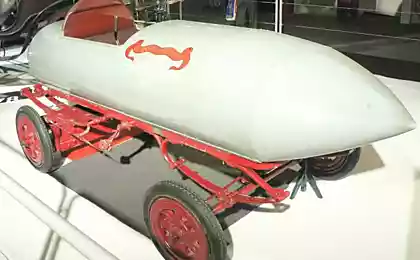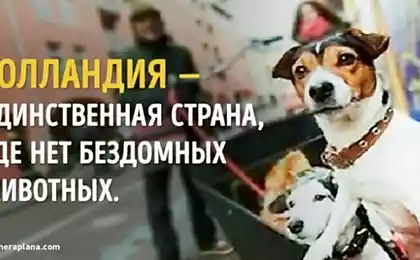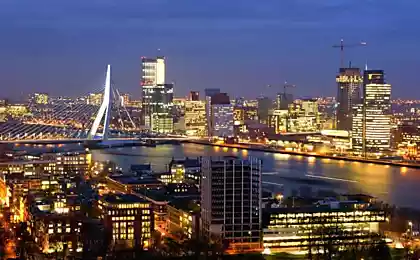1233
Electric transport in the Netherlands
Electric cars came to the Netherlands an innovative solution that could provide a host of new economic opportunities for the Dutch business community. The main directions of development of this industry are elektrozapravki and related infrastructure, manufacturing of parts and components for electric vehicles, as well as direct production of electric vehicles and light electric vehicles movement, including scooters and electric bikes.
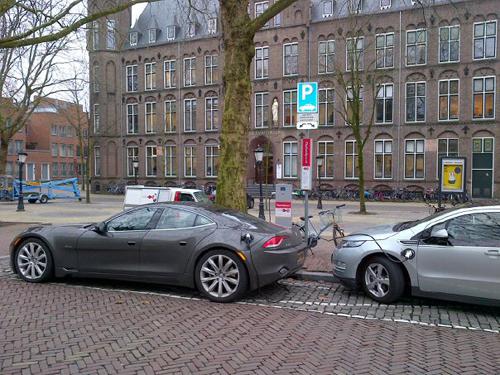
Ministry of Economy of the Netherlands at the time instructed the business combination of the Netherlands (Netherlands Enterprise Agency) to begin work on electric stimulation in the country, including to reduce CO2 emissions, improving energy efficiency, reduction of noise pollution in urban areas and reduce dependence on fossil fuel sources. Various Dutch companies, social institutions, research centers and government agencies are working directly in the Netherlands, and together with other international organizations, to accelerate the development of electric transport sector and take advantage of the related economic opportunities. And electric transport in the Netherlands is booming! The number of such machines in the country is increasing at a significant pace. The number of companies involved in this industry, as is continuously growing. So what is the success of electric transport in the Netherlands?

Number of electric passenger car vehicles in the Netherlands has increased from 607 units in 2010 to 7410 in 2012 and 46111 (!) In 2014. Number elektrozapravok also grew rapidly: from 400 public and private elektrozapravok in 2010 to 1840 - in 2011, to 3674 - in 2012 and 12114 unique elektrozapravok in 2014. This is despite the fact that many people in the country is only now beginning to understand the role of the electric and its prospects. The main goals set by the Dutch government, is to achieve, by 2015, from 15,000 to 20,000 electric cars (the end of 2013 the number of passenger electric vehicles in the Netherlands was already 30086) 2020 - 200 000 units of electric transport in the country and in 2025 - 1 million electric vehicles . And by 2050 it is planned that all the machines in the Netherlands were the only with an electric motor.
Sales growth in the number of electric vehicles on the background of a general reduction in the automotive market
Tesla Model S, BMW i3 and the Nissan Leaf were among the leaders in sales of "clean" electric vehicles (BEVs) in the Netherlands in 2014, Mitsubishi Outlander and the Volvo V60 - among elektrogibridov (PHEVs). In 2014 Mitsubishi Outlander in general took the tenth place in the list of cars sold in the country, including among cars with internal combustion engines. Total electric registered in the country has increased by 18% compared with 2013 year. And all this against the background of general market contraction in car sales in the country. The number of electric cars first registered in 2014 was 18 percent higher than in 2013. Sales of BEVs and PHEVs are 3, 86% of the total car sales in 2014 in the country, with the following ratio: 15% "clean" electric vehicles, and 85% - elektrogibridy. In general, it should be noted that the number of electric vehicles sold in the Netherlands is higher than in countries with their own electric plants manufacturers: Germany, France, Italy, South Korea and others.
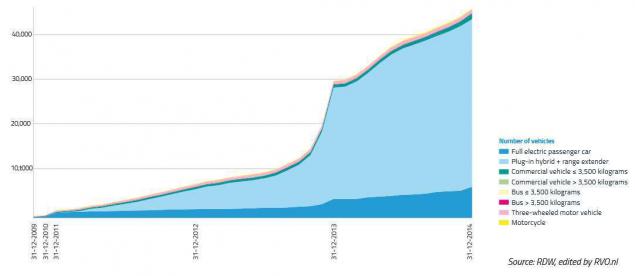
New models of electric
The growing number of electric vehicles in the country can be described as phenomenal, if not to take into account that electromobility technology greatly improved in recent years and the benefits of such machines is becoming increasingly evident. For example, even the Volkswagen - the best-selling car brand in the country (11% of the total car market in 2014godu) began to actively promote their own models of electric vehicles (e-Golf, e-Up! And others).

Concern which operates plants Volkswagen, Audi also owns factories and Porsche, wants to become a leader in the market and sales of electric vehicles in the country. Even from the very first elektrogibrid Volkswagen Golf GTE intended specifically for the Netherlands. In its quest for global leadership in the market of cars, Volkswagen announced it will introduce in the next few years, dozens of new models of electric cars. Representatives of Audi also announced that the company will invest several billion euros in the development of new electric vehicles. Other automakers like Volkswagen, also announced plans to release new models of electric vehicles in the coming years. Thus, the number of models of electric vehicles, at least double in the coming years, and this diversity every consumer finds himself vending electric model. It should be noted that experts predict the number of electric vehicles sold will grow from 324,000 units in 2014 to 2, 5 million in 2023.
Charging infrastructure
Another important factor is the availability of electric charging infrastructure. First elektrozapravki for everyday charging near the place of work, housing and other areas of long-term stay of people, and the availability of "fast" (including DC) elektrozapravok along national and interstate highways in the Netherlands. As noted earlier, there are more than 12,000 elektrozapravok. To achieve the goal of 200 thousand electric cars in the country by 2020, the government has also set a goal to run to this date elektrozapravochnyh 70,000 stations in the Netherlands. The country also participates in the European Declaration «Charging Everywhere» («Charges everywhere"), combining as currently more than 50 large companies. The declaration suggests that by 2020, people will be able to charge their electric cars in every street, in every town, on every road, and next to each office. And the activities of all organizations that have ratified the document, aimed at achieving this goal. Among the companies that signed the document are companies such as Nissan, Renault and BMW, Amsterdam (via the Investment Fund) and the Berlin company ABB, Schneider Electric and Siemens. It is also important to note that the number of private elektrozapravok also increased significantly (at least 6 times) in the country in recent years: from 4500-5500 in 2012 to about 28,000 in 2014. Also, the country is already operating more than 250 stations, "fast" charging along highways (for comparison, in 2011 - 14, in 2012 - 63, in 2013 - 106). And every week opened another such station along the road in the Netherlands.

One of the important achievements in this direction is the European Union's financial support for the construction of 155 "fast" elektrozapravok along the main roads, which would allow travel between the Netherlands, Germany, Denmark, Sweden, Norway and Austria, regardless of brand and brand electric vehicle. Starting data elektrozapravochnyh stations scheduled for late 2015.
The economic potential for the Netherlands
But it is not only the number of electric vehicles in the country is growing rapidly. Thus, the number of full-time jobs related to electric transport has increased from 400 seats in 2010 to 1,600 in 2013. And if you continue to electric transport will be developed at a pace (including taking into account the achievements in 2020 200 000 EVs), the number of workers places associated with electrified in the Netherlands will increase to 10 150. It is estimated that each electric vehicle sold in the Netherlands gives the Dutch economy at least € 11 000 income. Every sold 20 electric vehicles to create an additional one workplace. And according to experts from the Rotterdam University of Applied Sciences, the increase in the number of workers to electric transport industry 10,150 can bring at least 1, 2 billion. € in the country's GDP.
Moreover, the number of jobs is related not only to sales of electric vehicles, as well as due to the development of infrastructure and networks elektrozapravochnoy Smart Grid. Storing electricity in the batteries of passenger transport may be used for the distribution networks. Thereby increasing the efficiency of solar power plants, which would be used as a storage battery power. At night, when charging electric vehicles, will also smooth out the "night" failures graphs of electrical loads.

Public opinion
An important role in the development of electric transport in the Netherlands is public opinion. So, in 2011, 41% of the total population of the Netherlands supported the concept of the gradual replacement of conventional vehicles to electric.
More recent studies have shown that 26% of people who will buy a new car in the future, are seriously considering the possibility of buying "pure" electric or elektrogibrida.
The main reason for the transition to electric transport 75% of respondents cited concern for the environment. At the same time, they note that the purchase of an electric vehicle is too expensive compared to buying a traditional car. However, recent calculations show that because of the significant tax incentives for the purchase and possession of an electric vehicle during the operation and make the purchase of electric vehicles for the inhabitants of the country economically more attractive as compared to machines with internal combustion engines.
Tax incentives
In recent years, the Dutch government has granted significant tax incentives for owners and buyers of "clean" electric vehicles and elektrogibridov. In particular, the size of the value added tax when purchasing an electric company was in 2013 - 0%, with a 25% tax for conventional vehicles. With this number of passenger EVs in the Netherlands increased by 23,000 in 2013. Total budgetary losses from the government of tax incentives was € 527 million in 2013. In 2014, these benefits were able to get only a few companies and organizations.
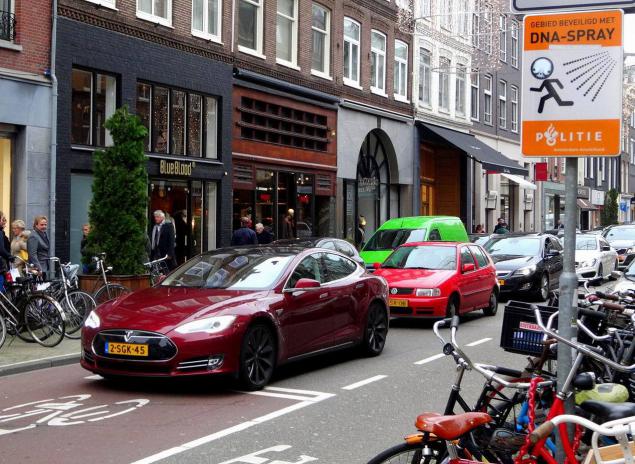
It should be noted that owners of electric cars are free to find a parking place in Amsterdam, the capital of the Netherlands, on the specially designated areas, including those near his residence. And they can do it for free. At the same time, some owners of conventional vehicles have to wait 10 years for the parking lot near the residence for your car with a combustion engine.
Elektrogibrid (PHEV) as a transitional electric
Most people difficult to go directly to electric vehicles. Including, for fear of "becoming" middle of the road while reducing the charge to 0% and the need to have their own elektrozaryadku near the house (especially for residents of high-rise buildings). For this category of people one of the output can be to switch to elektrogibridy which will consume much less fuel as compared to conventional cars. In 2014, many motor companies have formed an ad hoc coalition of manufacturers elektrogibridov «Plug-In Coalition». Their main purpose is to minimize the gap between producers elektrogibridov on the declared fuel efficiency and actual consumption of gasoline or diesel per kilometer. The Coalition is working with various research organizations that conduct various monitoring and research on public opinion. Also, the coalition has an impact on the formation and change people's opinions about electric.
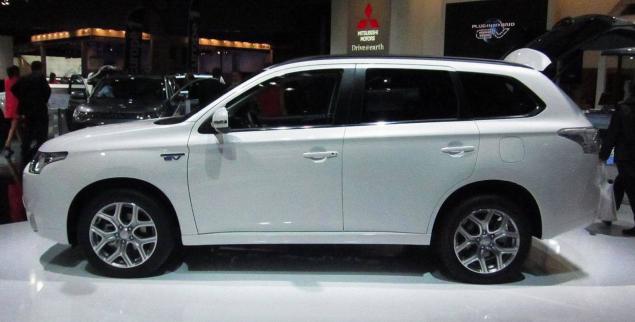
It is believed that elektrogibridy made a significant contribution to the development of the charging infrastructure in the country. It is also noted that the transition to "clean" electric cars are much easier to make elektrogibridov owners.
Evaluation of electric
In recent years, several international universities and
research institutions that are constantly exploring modes of passenger electric vehicles. Charging electric vehicles "green" energy from renewable energy sources (RES) do environmental benefits of electric transport more significant. At realization of the negative scenario - charging of electric power generated at coal-fired power - make electric slightly cleaner than conventional vehicles with internal combustion engines. However, according to estimates of the Dutch Energy, charging the electric power generated from the "mix" of fuel sources (natural gas, coal and renewable energy sources) can reduce CO2 emissions by 50%! One reason for this reduction is also the fact that electrotransport uses regenerative braking mode of the motor. It is also noted that electric vehicles do not have emission of nitrogen oxides NOx, particularly harmful to the atmosphere.

In addition to passenger EVs, are candidates for electrification of buses, trucks, scooters and mopeds. In this direction, the Dutch government conducted significant work and planned that by 2020 will not be buses with traditional internal combustion engines. At the end of 2014 were registered 80 passenger electric bus (5000 bus in the country, that is, 1, 6%), and 46 of electric trucks (& gt; 3, 5 tons, from 137000 - i.e. 0 , 03%). With regard to the two-wheeler and "light" vehicles in the country at the end of 2014 registered 3,441 electric mopeds, electric scooters 27291 (from 1.122 million, 2%) and 169 (653 000, 0, 02%) Electrical motorcycles. Total in the country at the end of 2014 recorded 73,574 units of electric, including scooters, buses and ATVs.
Separately it is necessary to allocate bikes with an electric drive. In total, the country has already sold more than 1, 1 million of these bikes. In general, the country operated for about 19 million bicycles (with a population of 16, 8 million), ie, electric bicycles account for nearly 6% of their total number.
The basic models of electric vehicles, and passenger elektrogibridov are Mitsubishi Outlander P-HEV (14567 machines to September 2014), Volvo V60 Plug-in Hybrid (8941), Opel Ampera (4970), Toyota Prius PHV (3978), Tesla Model S (2150) , Nissan Leaf (1280), Chevrolet Volt (1066) and others.
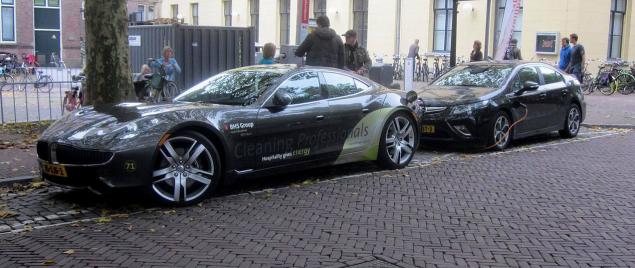
P.S. Images are given as illustrations and are not copyrighted.
Source: geektimes.ru/post/251786/

Ministry of Economy of the Netherlands at the time instructed the business combination of the Netherlands (Netherlands Enterprise Agency) to begin work on electric stimulation in the country, including to reduce CO2 emissions, improving energy efficiency, reduction of noise pollution in urban areas and reduce dependence on fossil fuel sources. Various Dutch companies, social institutions, research centers and government agencies are working directly in the Netherlands, and together with other international organizations, to accelerate the development of electric transport sector and take advantage of the related economic opportunities. And electric transport in the Netherlands is booming! The number of such machines in the country is increasing at a significant pace. The number of companies involved in this industry, as is continuously growing. So what is the success of electric transport in the Netherlands?

Number of electric passenger car vehicles in the Netherlands has increased from 607 units in 2010 to 7410 in 2012 and 46111 (!) In 2014. Number elektrozapravok also grew rapidly: from 400 public and private elektrozapravok in 2010 to 1840 - in 2011, to 3674 - in 2012 and 12114 unique elektrozapravok in 2014. This is despite the fact that many people in the country is only now beginning to understand the role of the electric and its prospects. The main goals set by the Dutch government, is to achieve, by 2015, from 15,000 to 20,000 electric cars (the end of 2013 the number of passenger electric vehicles in the Netherlands was already 30086) 2020 - 200 000 units of electric transport in the country and in 2025 - 1 million electric vehicles . And by 2050 it is planned that all the machines in the Netherlands were the only with an electric motor.
Sales growth in the number of electric vehicles on the background of a general reduction in the automotive market
Tesla Model S, BMW i3 and the Nissan Leaf were among the leaders in sales of "clean" electric vehicles (BEVs) in the Netherlands in 2014, Mitsubishi Outlander and the Volvo V60 - among elektrogibridov (PHEVs). In 2014 Mitsubishi Outlander in general took the tenth place in the list of cars sold in the country, including among cars with internal combustion engines. Total electric registered in the country has increased by 18% compared with 2013 year. And all this against the background of general market contraction in car sales in the country. The number of electric cars first registered in 2014 was 18 percent higher than in 2013. Sales of BEVs and PHEVs are 3, 86% of the total car sales in 2014 in the country, with the following ratio: 15% "clean" electric vehicles, and 85% - elektrogibridy. In general, it should be noted that the number of electric vehicles sold in the Netherlands is higher than in countries with their own electric plants manufacturers: Germany, France, Italy, South Korea and others.

New models of electric
The growing number of electric vehicles in the country can be described as phenomenal, if not to take into account that electromobility technology greatly improved in recent years and the benefits of such machines is becoming increasingly evident. For example, even the Volkswagen - the best-selling car brand in the country (11% of the total car market in 2014godu) began to actively promote their own models of electric vehicles (e-Golf, e-Up! And others).

Concern which operates plants Volkswagen, Audi also owns factories and Porsche, wants to become a leader in the market and sales of electric vehicles in the country. Even from the very first elektrogibrid Volkswagen Golf GTE intended specifically for the Netherlands. In its quest for global leadership in the market of cars, Volkswagen announced it will introduce in the next few years, dozens of new models of electric cars. Representatives of Audi also announced that the company will invest several billion euros in the development of new electric vehicles. Other automakers like Volkswagen, also announced plans to release new models of electric vehicles in the coming years. Thus, the number of models of electric vehicles, at least double in the coming years, and this diversity every consumer finds himself vending electric model. It should be noted that experts predict the number of electric vehicles sold will grow from 324,000 units in 2014 to 2, 5 million in 2023.
Charging infrastructure
Another important factor is the availability of electric charging infrastructure. First elektrozapravki for everyday charging near the place of work, housing and other areas of long-term stay of people, and the availability of "fast" (including DC) elektrozapravok along national and interstate highways in the Netherlands. As noted earlier, there are more than 12,000 elektrozapravok. To achieve the goal of 200 thousand electric cars in the country by 2020, the government has also set a goal to run to this date elektrozapravochnyh 70,000 stations in the Netherlands. The country also participates in the European Declaration «Charging Everywhere» («Charges everywhere"), combining as currently more than 50 large companies. The declaration suggests that by 2020, people will be able to charge their electric cars in every street, in every town, on every road, and next to each office. And the activities of all organizations that have ratified the document, aimed at achieving this goal. Among the companies that signed the document are companies such as Nissan, Renault and BMW, Amsterdam (via the Investment Fund) and the Berlin company ABB, Schneider Electric and Siemens. It is also important to note that the number of private elektrozapravok also increased significantly (at least 6 times) in the country in recent years: from 4500-5500 in 2012 to about 28,000 in 2014. Also, the country is already operating more than 250 stations, "fast" charging along highways (for comparison, in 2011 - 14, in 2012 - 63, in 2013 - 106). And every week opened another such station along the road in the Netherlands.

One of the important achievements in this direction is the European Union's financial support for the construction of 155 "fast" elektrozapravok along the main roads, which would allow travel between the Netherlands, Germany, Denmark, Sweden, Norway and Austria, regardless of brand and brand electric vehicle. Starting data elektrozapravochnyh stations scheduled for late 2015.
The economic potential for the Netherlands
But it is not only the number of electric vehicles in the country is growing rapidly. Thus, the number of full-time jobs related to electric transport has increased from 400 seats in 2010 to 1,600 in 2013. And if you continue to electric transport will be developed at a pace (including taking into account the achievements in 2020 200 000 EVs), the number of workers places associated with electrified in the Netherlands will increase to 10 150. It is estimated that each electric vehicle sold in the Netherlands gives the Dutch economy at least € 11 000 income. Every sold 20 electric vehicles to create an additional one workplace. And according to experts from the Rotterdam University of Applied Sciences, the increase in the number of workers to electric transport industry 10,150 can bring at least 1, 2 billion. € in the country's GDP.
Moreover, the number of jobs is related not only to sales of electric vehicles, as well as due to the development of infrastructure and networks elektrozapravochnoy Smart Grid. Storing electricity in the batteries of passenger transport may be used for the distribution networks. Thereby increasing the efficiency of solar power plants, which would be used as a storage battery power. At night, when charging electric vehicles, will also smooth out the "night" failures graphs of electrical loads.

Public opinion
An important role in the development of electric transport in the Netherlands is public opinion. So, in 2011, 41% of the total population of the Netherlands supported the concept of the gradual replacement of conventional vehicles to electric.
More recent studies have shown that 26% of people who will buy a new car in the future, are seriously considering the possibility of buying "pure" electric or elektrogibrida.
The main reason for the transition to electric transport 75% of respondents cited concern for the environment. At the same time, they note that the purchase of an electric vehicle is too expensive compared to buying a traditional car. However, recent calculations show that because of the significant tax incentives for the purchase and possession of an electric vehicle during the operation and make the purchase of electric vehicles for the inhabitants of the country economically more attractive as compared to machines with internal combustion engines.
Tax incentives
In recent years, the Dutch government has granted significant tax incentives for owners and buyers of "clean" electric vehicles and elektrogibridov. In particular, the size of the value added tax when purchasing an electric company was in 2013 - 0%, with a 25% tax for conventional vehicles. With this number of passenger EVs in the Netherlands increased by 23,000 in 2013. Total budgetary losses from the government of tax incentives was € 527 million in 2013. In 2014, these benefits were able to get only a few companies and organizations.

It should be noted that owners of electric cars are free to find a parking place in Amsterdam, the capital of the Netherlands, on the specially designated areas, including those near his residence. And they can do it for free. At the same time, some owners of conventional vehicles have to wait 10 years for the parking lot near the residence for your car with a combustion engine.
Elektrogibrid (PHEV) as a transitional electric
Most people difficult to go directly to electric vehicles. Including, for fear of "becoming" middle of the road while reducing the charge to 0% and the need to have their own elektrozaryadku near the house (especially for residents of high-rise buildings). For this category of people one of the output can be to switch to elektrogibridy which will consume much less fuel as compared to conventional cars. In 2014, many motor companies have formed an ad hoc coalition of manufacturers elektrogibridov «Plug-In Coalition». Their main purpose is to minimize the gap between producers elektrogibridov on the declared fuel efficiency and actual consumption of gasoline or diesel per kilometer. The Coalition is working with various research organizations that conduct various monitoring and research on public opinion. Also, the coalition has an impact on the formation and change people's opinions about electric.

It is believed that elektrogibridy made a significant contribution to the development of the charging infrastructure in the country. It is also noted that the transition to "clean" electric cars are much easier to make elektrogibridov owners.
Evaluation of electric
In recent years, several international universities and
research institutions that are constantly exploring modes of passenger electric vehicles. Charging electric vehicles "green" energy from renewable energy sources (RES) do environmental benefits of electric transport more significant. At realization of the negative scenario - charging of electric power generated at coal-fired power - make electric slightly cleaner than conventional vehicles with internal combustion engines. However, according to estimates of the Dutch Energy, charging the electric power generated from the "mix" of fuel sources (natural gas, coal and renewable energy sources) can reduce CO2 emissions by 50%! One reason for this reduction is also the fact that electrotransport uses regenerative braking mode of the motor. It is also noted that electric vehicles do not have emission of nitrogen oxides NOx, particularly harmful to the atmosphere.

In addition to passenger EVs, are candidates for electrification of buses, trucks, scooters and mopeds. In this direction, the Dutch government conducted significant work and planned that by 2020 will not be buses with traditional internal combustion engines. At the end of 2014 were registered 80 passenger electric bus (5000 bus in the country, that is, 1, 6%), and 46 of electric trucks (& gt; 3, 5 tons, from 137000 - i.e. 0 , 03%). With regard to the two-wheeler and "light" vehicles in the country at the end of 2014 registered 3,441 electric mopeds, electric scooters 27291 (from 1.122 million, 2%) and 169 (653 000, 0, 02%) Electrical motorcycles. Total in the country at the end of 2014 recorded 73,574 units of electric, including scooters, buses and ATVs.
Separately it is necessary to allocate bikes with an electric drive. In total, the country has already sold more than 1, 1 million of these bikes. In general, the country operated for about 19 million bicycles (with a population of 16, 8 million), ie, electric bicycles account for nearly 6% of their total number.
The basic models of electric vehicles, and passenger elektrogibridov are Mitsubishi Outlander P-HEV (14567 machines to September 2014), Volvo V60 Plug-in Hybrid (8941), Opel Ampera (4970), Toyota Prius PHV (3978), Tesla Model S (2150) , Nissan Leaf (1280), Chevrolet Volt (1066) and others.

P.S. Images are given as illustrations and are not copyrighted.
Source: geektimes.ru/post/251786/


